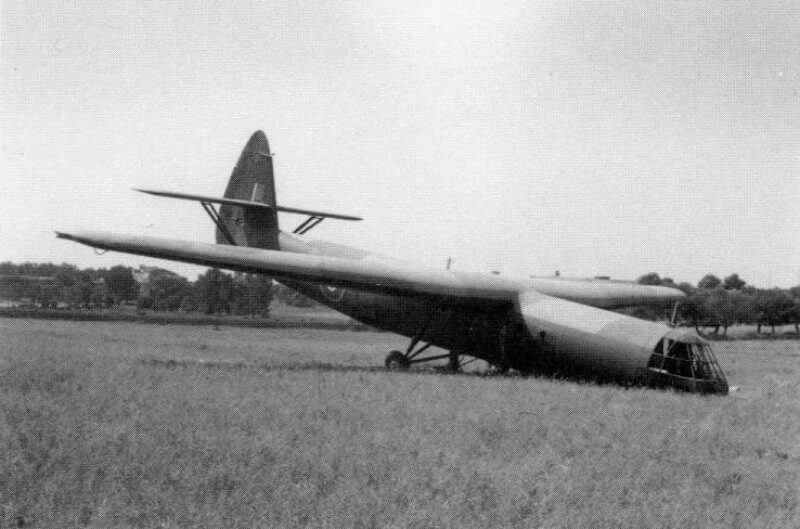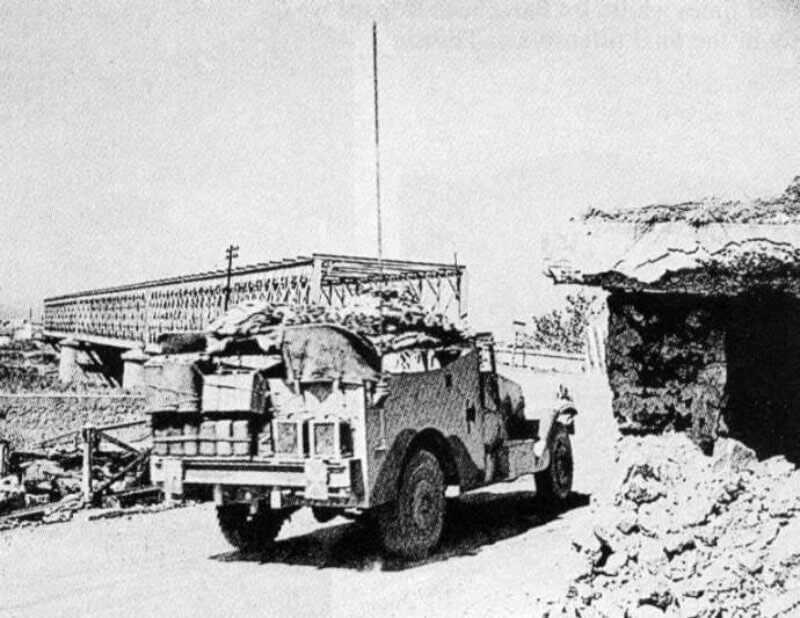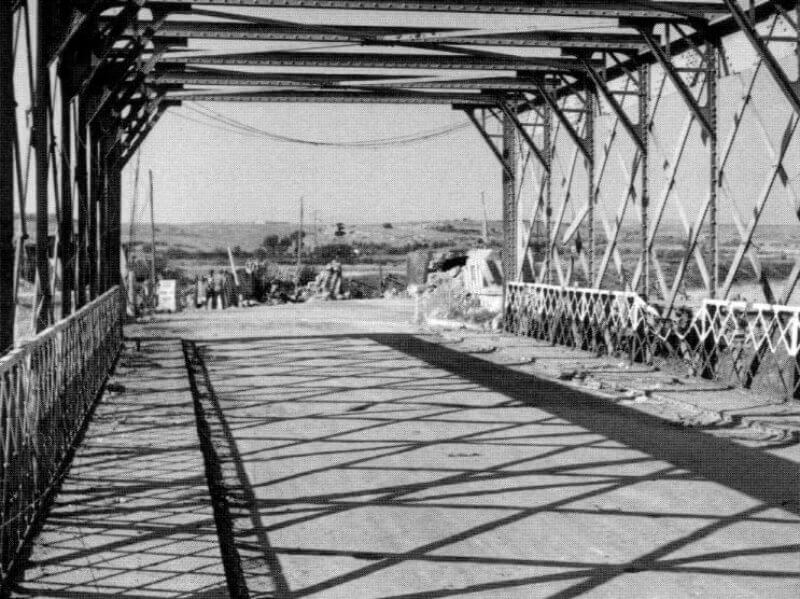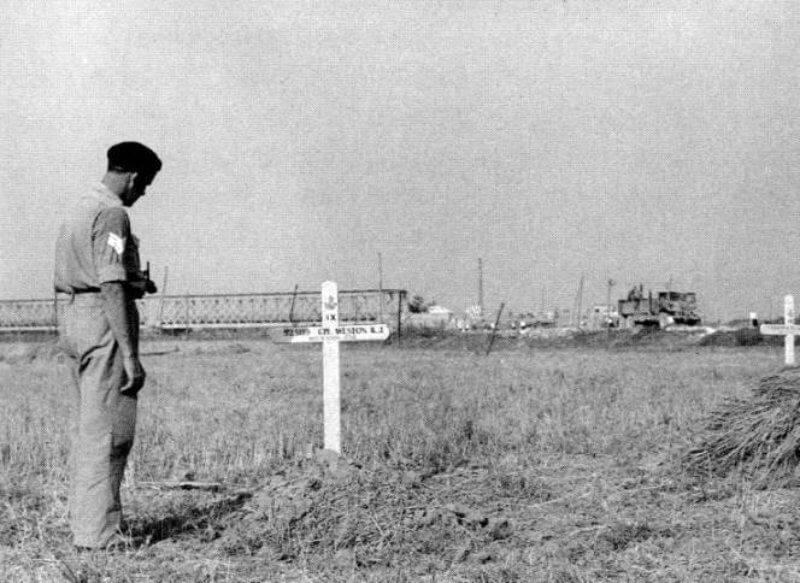| Page Created |
| December 4th, 2024 |
| Last Updated |
| December 4th, 2024 |
| Great Britain |
 |
| Special Forces |
| 1st Airborne Division The Glider Pilot Regiment |
| Related Operations |
| Operation Mincemeat Operation Turkey Buzzard/Operation Beggar Operation Narcissus Operation Husky Operation Husky, Special Raiding Squadron Operation Husky No. 1 Operation Ladbroke Operation Ladbroke, Coup de Main Operation Husky No. 2 Operation Fustian Operation Chestnut Special Raiding Squadron, Raid on Augusta |
| Related Pages |
| Airspeed Horsa WACO CG-4A |
| Date |
| Operation Ladbroke, Coup de Main |
| Objectives |
- Coup de Main raid on the Ponte Grande Bridge bridges by A and C Companies of the 2nd Battalion, South Staffordshire Regiment.
| Operational Area |


| Allied Forces |
- 2nd Battalion, South Staffordshire Regiment
- A Company
- C Company
- 9th Field Company, Royal Engineers
| Axis Forces |
- 54ª Divisione di fanteria “Napoli”
| Operation |
The most crucial phase of Operation Ladbroke is the coup-de-main raid on the Ponte Grande and railway Bridge in Sicily by A and C Companies of the 2nd Battalion, South Staffordshire Regiment. While the rest of the 1st Airlanding Brigade flies to Sicily in Waco gliders, the coup-de-main units are transported in Airspeed Horsa gliders towed by the Royal Air Force, in the hope that this combination would improve their chances of landing successfully. Although there is some statistical improvement, the operation is still chaotic.
The leadership of Company A during the Coup de Main Phase of Operation Ladbroke comprises several officers and senior non-commissioned officers tasked with overseeing the operation.
- Company Commander: Major T.B. Lane
- Second-in-Command: Captain J.B. McCooke
- Platoon Commanders: Lieutenant R.A. Barrett, Lieutenant A.R. Clowes, Lieutenant R.G. Williams
- Company Sergeant Major: CSM R. Woolhouse
- Sergeant: Sgt V. Williams
For the operation, Company A is assigned four Airspeed Horsa gliders, designated as Nos. 128, 129, 130, and 131, to transport the personnel and equipment necessary for their mission.
The leadership of Company C during the Coup de Main Phase during Operation Ladbroke includes the following officers and senior non-commissioned officers:
- Company Commander: Major E.G. Ballinger
- Second-in-Command: Captain E.M. Wyss
- Platoon Commanders: Lieutenant L. Withers, Lieutenant R.S. Robey, Lieutenant H.D. Scott, Second Lieutenant J. Badger
- Company Sergeant Major: CSM L. Knight
Company C is assigned four Airspeed Horsa gliders, designated as Nos. 132, 133, 134, and 135, to transport personnel and equipment required for their mission.
One of the reinforcements for the Coup de Main party is a unit informally known as Simforce, a composite force of 2nd, Battalion, South Staffordshire Regiment troops. They are part of a unit led by Captain Simonds. This unit is not part of the standard rifle companies and is designated as a battalion reserve. Simforce is distributed across three gliders: Glider Z, Glider 53a, and Glider 54a. The unit is added only 36 hours before when three more gliders become available.
Lieutenant Colonel A.G. Walch’s desire to participate in the mission leads to the inclusion of Glider Z. Lieutenant Colonel Walch is one of the key figures in the establishment of British airborne forces, alongside Major General Frederick Browning. Both men are instrumental in the creation of the 1st Airborne Division, though neither officially serves in the division anymore. Browning is now the chief advisor on airborne operations to General Eisenhower, the Allied Commander-in-Chief, and has taken Walch with him as his Chief of Staff.
This gives Walch considerable influence, and he decides to accompany the men of the 1st Airlanding Brigade to observe the fighting firsthand. He classifies himself as a spectator, which, in theory, removes him from the chain of command during the battle. The exact number of aides or staff members accompanying him is unknown, but it is estimated to be between two and five, depending on the configuration of the glider.
Regardless of the number of aides, ten seats remain available for fighting troops, which are assigned to the men of Simforce, led by Lieutenant Jack Reynolds. The unit included two medical ordeley’s of the 181st (Airlanding) Field Ambulance, Royal Army Medical Corps.
| Railway Bridge |
Company A commanded by Major T.B. Lane, is assigned four Horsa gliders with the objective of landing northwest of the railway bridge on Landing Zone 3 over the canal to capture it.
During the operation, the glider of the Company Commander, Lieutenant Barrett, Company Sergeant Major Woolhouse, and No. 7 Platoon crash into the sea. Company Sergeant Major Woolhouse tragically drowns, while Major Lane, Lieutenant Barrett, and two other ranks manage to swim ashore. The rest of the platoon, left on the glider, are eventually picked up by Naval craft the following day.
No. 8 Platoon, under the command of Sergeant V. Williams, along with Captain McCooke as second-in-command, crash-lands well south of their intended landing zone. In their effort to establish their location, they are engaged by enemy forces, leading to the separation of Captain McCooke and one other member of the platoon. Both groups encounter minor skirmishes with the enemy in the area around their objective. Despite this, No. 8 Platoon advances, eventually capturing the high ground south of the bridge, their designated objective. They hold their position against Italian counterattacks and make an attempt to seize the bridge later in the day, but the Italian defences prove too strong, and they are forced to withdraw. Eventually, the entire group is captured around 15:00 hours, but they are soon liberated by the 2nd Battalion, Northamptonshire Regiment, arriving from the invasion beaches. while Captain McCooke manages to escape captivity.
No. 9 Platoon, led by Lieutenant R.G. Williams, lands in the sea off the Bay of Syracuse. Following the landing, only 16 men are present on the wings during the roll call. At daybreak, Lieutenant Williams and six of his men set out to swim ashore, while the remaining eight are picked up by an Italian launch and transported to Syracuse. Four of these men are taken to a hospital, where they are later found after the city is captured. The remaining members of No. 9 Platoon have not been heard from.
No. 10 Platoon, under the command of Lieutenant A.R. Cloves, was reportedly released over the landing zone by the Royal Air Force tug pilot. Since that point, there has been no communication or report regarding the platoon’s whereabouts.
| Ponte Grande Road Bridge |
C Company’s landing near the Ponte Grande road bridge is more successful, with all four gliders reaching Sicily, and two landing on their intended zone.
No. 15 Platoon, led by Lieutenant Withers, lands between the designated landing zone and the bridge. More about that later
No. 16 Platoon, under Lieutenant Robey, crash-lands about 16 kilometres southwest of the objective. Their glider comes under enemy fire shortly after landing and bursts into flames. Lieutenant Robey and 15 other ranks are killed. The surviving members of the platoon make their way to the coast, where they join seaborne forces.
No. 17 Platoon in Glider No. 132, led by Lieutenant Scott along with Major Ballinger, half of Company Headquarters and a small detachment of sappers from the 9th Field Company, Royal Engineers, crash-lands approximately 180 metres upstream from the bridge, resulting in the glider bursting into flames. It is believed that machine-gun fire ignites explosives carried by the engineers. Only three survive, Lieutenant Scott and two other ranks, all of whom sustain serious injuries. Major Ballinger, Acting Company Sergeant Major Knight, and the rest of the personnel perish in the crash.
No. 18 Platoon, commanded by Lieutenant Badger, carries the Company Second-in-Command, Captain Wyss, and the rest of Company Headquarters. Their glider crash-lands around 9.5 kilometres west of the objective. Captain Wyss is injured upon landing and, along with his batman, is captured and imprisoned in the Florida Jail. He is freed the next day as British forces approach and, after his release, assists in freeing the prisoners held in the jail. Despite Lieutenant Badger being wounded in the hand, the platoon manages to reach the bridge the following day, engaging in minor skirmishes en route.
Shortly after, at 22:45, Glider No. 133 with No. 15 Platoon aboard approaches the landing zone and also comes under fire but manages to land safely on Landing Zone 3. Lieutenant Lennard Withers and his No. 15 Platoon immediately disembark and move towards the bridge. Thus, only one platoon of the 2nd Battalion, South Staffordshire Regiment, is available to participate in the coup-de-main raid on the Ponte Grande bridge.
Unaware of their isolation, No. 15 Platoon finds cover and waits for the rest of C Company. After several minutes, it becomes clear that no reinforcements are arriving, and Lieutenant Withers decides to press on with an attack on the bridge, despite only having 30 men.
Withers divides his men into two groups. He leads the smaller group of six across the Canal Mammaiabica to attack a pillbox on the northern side of the bridge, drawing enemy fire. The remaining platoon members then rush the bridge from the southern side. Taken by surprise, the Italian defenders fire only a few shots before surrendering, and No.15 Platoon captures the Ponte Grande bridge without suffering any casualties.
The attached sappers from the 9th Field Company, Royal Engineers sever telephone cables and remove the detonators from the demolition charges placed around the bridge, while Withers organises his men into defensive positions. The small, lightly armed force is ill-equipped to hold the bridge against a determined counterattack, but Withers hopes they can defend it until reinforcements arrive. The first challenge comes swiftly but is poorly executed: a truck carrying 12 Italian soldiers approaches the bridge but is fired on by Lance Corporal Pratt’s section, resulting in all occupants being killed.
| Reinforcements |
There is still no sign of the rest of C Company, but reinforcements from the main landing zones begin to arrive from 04:30 onwards. Lieutenant Welch is the first to reach the bridge, bringing seven men from the 1st Airlanding Brigade Defence Platoon. Lieutenant Welch of Brigade Headquarters, lands in WACO CG-4A Glider No. 6, approximately eight hundred metres inland on the southern peninsula near Syracuse at 22:15 hours. Despite a minor crash upon landing, the glider party quickly assembles their handcart and moves northwest. Around 23:30 hours, they encounter an enemy patrol of four men. Two are killed, one is taken prisoner, and the fourth escapes. Guided by the captured enemy soldier, persuaded by Staff Sergeant Taylor, the party avoids enemy positions and proceeds along the coastal road toward Ponte Grande.
During their advance, the group faces challenges from hostile civilians who appear to be acting as a local militia. These individuals are neutralised, allowing the group to continue unhindered. By 03:00 hours on 10 July, the glider party encounters a load of the 181st Field Ambulance east of a Strong Point. Here, they meet Major Du Boulay of the 1st Battalion, The Border Regiment, who informs them that the road ahead is held by enemy forces. Du Boulay leads part of the group around the position while leaving the signallers and their handcart with the Field Ambulance. However, Du Boulay becomes separated from the group during this manoeuvre, prompting the party to rest while the bombing of Syracuse unfolds.
After the bombing subsides, the group decides to proceed across country toward Ponte Grande. They arrive at approximately 04:30 hours. The seven men under Welch integrate into the defensive positions, reinforcing Withers’ platoon. A captured pillbox serves as a makeshift first aid post for the wounded.
Of Simforce the brigade’s reserve, both WACO CG-4A Gliders 53a and 54a land in the sea, leaving the detachment in WACO CG-4A Glider Z as the only representatives of Simforce able to participate in the fighting.
After Glider Z lands the men insideand assessing their surroundings, Lieutenant Colonel Walch and his group prepare to move towards the Ponte Grande bridge, codenamed Waterloo.
Lieutenant Jack Reynolds, the senior officer of Simforce in Glider Z. Reynolds argues with Walch about the route to take, as he is under orders to take a different path. Although Lieutenant Colonel Walch is of much higher rank, Reynolds disregards him since Walch is officially only an observer. Walch opts for a circuitous route to avoid known Italian strongpoints. Given that he is not under 1st Airlanding Brigade orders, this independent decision proves wise, as his party arrives at the bridge without casualties.
Lieutenant Reynolds leads his men along the original planned route, but they are less fortunate. As Reynolds leads his party throughout the night to Waterloo Bridge, they encounter stiff opposition along the way, during which six of his nine men became casualties. Private F.J. Back, one of the medical orderlies, is killed by machine-gun fire shortly after landing. On the way, Reynolds gathers several stragglers, forming them into an organised group.
Meanwhile, Lieutenant Colonel Walch finds the area puzzlingly quiet. He wonders where the hundreds of airborne troops who should have been fighting nearby are located. Unbeknownst to him, most have either landed miles away or have come down in the sea. Setting off with his “amateur” party, Lieutenant Colonel Walch skirts the Italian gun battery codenamed Mosquito. They eventually encounter a group of about 30 glider troops on a back road and join them. Part of this group is Major Basil Saunders Beazley, commander of the 9th Field Company, Royal Engineers reaches the bridge at around 05:00 with 15 sappers. Major Beazley had landed with WACO CG-4A Glider No. 38, in a tomato plantation. The crew successfully unloads the equipment but is immediately forced to abandon it due to incoming fire. They proceed north along the road towards the Italian strongpoint codenamed Bilston, which they bypass to the north. While doing so they meet the group of Lieutenant Colonel Walch.
To avoid the enemy, they proceed cautiously and arrive near the strongpoint codenamed Walsal at 04:40. Lieutenant Colonel Walch decides to continue directly to the Ponte Grande bridge without engaging the Italian post that is now firing at them. They reach the bridge at approximately 05:00 without further trouble, though enemy machine-gun fire from battery Gnat falls just short as they cross the open ground to the south.
Upon reaching the bridge, Lieutenant Colonel Walch becomes the senior officer present and assumes command. Upon arrival, Major Beazley promptly removes the demolition charges from the bridge. The group then joins in the defence of the bridge. Other parties continue to trickle in throughout the morning. By 06:30, Lieutenant Deuchar, along with half of No. 12 Platoon of B Compan arrives. Followed by Lieutenant Reynolds part of Simforce, by now a mixed group of about 23 other ranks, bringing the total airborne strength at the bridge to around seven officers and 80 men.
However, this remains an inadequate force to repel a determined attack, and their limited weaponry, small arms with very little ammunition, is a significant handicap. The only support weapons are four Bren light machine guns and two mortars (one 2-inch and one 3-inch). The 2-inch mortar is loaded with only smoke rounds, while the 3-inch mortar has a limited supply of high explosive rounds, which are used to knock out an enemy mortar position to the southeast, leaving only three rounds for emergencies.
At 07:00, a lorry carrying Italian troops approaches from the north, seemingly unaware of the danger. It is ambushed by the British, and the occupants are killed. Despite these poorly executed probes, enemy pressure steadily mounts. Around 08:00, the bridge and forward positions come under heavy and accurate mortar fire from the west and north. During this bombardment, a blockhouse on the northern side of the bridge is directly hit, killing all the Italian prisoners of war inside. Colonel Walsh organises the defence, splitting the force into eastern and western sections. Welch and two of his men take up positions on the eastern side, while the rest hold the western section.
Sixteen glider pilots, along with four or five additional personnel, regroup on the southern bank of the southernmost canal. The group holds their position for nearly an hour, despite the overwhelming challenges. Over the next hour, all defending troops are withdrawn to positions along the canal. Lieutenant Welch and two sections, including Reynolds, take up positions on the east side of the bridge, while the remaining force holds the west side. Until noon, light machine guns keep the enemy at bay while the defenders rest.
At 12:20, the artillery barrage ceases, but mortar and machine-gun fire continue as a battalion of Italian infantry prepares to launch an assault. The flat terrain offers little cover, and enemy mortars make short work of the British defences. During this time, the remnants of the force on the northern bank face a dire situation, with all members either killed, wounded, or captured. The resilience and tenacity of those on the southern bank highlight their commitment to maintaining the defence against increasingly adverse conditions. With ammunition now critically low, the British can only fire single rounds. At 12:45, they move to a stronger position east of the bridge, hoping to hold out a bit longer.
At approximately 14:30 hours, Major Beazley, the second-in-command, bravely swims across the canal to join the group at Southeatern corner but is tragically met with a burst of machine-gun fire, killing him and Staff Sergeant Wikner. The same burst of fire narrowly misses another member of the group, grazing their cheek, hitting their pack with two bullets, and striking their rifle directly.
| Under Pressure |
By mid-afternoon, the western positions are overrun, and Italians are spotted south of the railway bridge, suggesting the enemy has secured it. A heavy machine gun establishes a position on the bridge, enfilading the canal, while mortar fire drives the remaining defenders toward the sea.
Welch and six others withdraw to a parallel ditch, avoiding exposure to the machine gun’s line of sight. Without ammunition, engaging the enemy is deemed futile. By 14:45, all outlying defence posts have been overrun. British casualties increase dramatically, and by 15:15, only around 20 men remain unwounded and able to fight. They are cornered where the canal meets the sea. As the intensity of the engagement increases, half of the defenders take cover in the canal itself, seeking the protection offered by the bank. Italian soldiers, emboldened by the situation, break cover to launch hand grenades at the group but are swiftly dealt with. The defenders eventually withdraw to a dry ditch, continuing to resist until their ammunition is depleted. Despite the lack of firepower, they maintain vigilance, eliminating any Italian soldier who ventures too close. However, the situation becomes increasingly untenable, with multiple machine guns, some as close as 40 metres, enfilading their position. With no cover and almost no ammunition, the remaining force is overwhelmed by the Italians at 15:30 and the order to surrender is given. Lieutenant Welch and seven men manage to evade capture by hiding nearby, but the rest are taken prisoner.
As they are being led away, they manage to turn the tables on their Italian captors when they encounter a patrol from the Northants Regiment. Meanwhile, the bridge is secured by men of the Royal Scots Fusiliers, who take control in their absence.
The Airborne Soldiers and Glider Pilts that had been ordered to take up a position on a ridge overlooking the bridge are surrounded. They fight in the ruins of an ancient Greek temple to Zeus, until they are completely surrounded and the men are forced to surrender. Many of them wounded.
The Italians are euphoric over their success. Some British prisoners fear they may be executed on the spot due to the apparent triumphalism of their captors. However, they are treated correctly and are marched away with a group of other prisoners, including members of the 1st Airlanding Brigade and the 8th Army. Lieutenant Colonel Walch and the rest of his force, now prisoners, are marched west for around 45 minutes, picking up other airborne prisoners along the way. The wounded are transported to an Italian hospital in Syracuse, where they receive treatment for their wounds. They walking British Prisoners of War remain in captivity for another 45 minutes before their Italian guards stumble into a unit from the 15th Infantry Brigade, which swiftly overcomes them. They receive permission from Brigadier G.W. Tarleton, commander of the 17th Infantry Brigade, to return to Ponte Grande, and by 21:00, they are once again defending the bridge, now armed with captured Italian weapons.
At 16:00 hours, approximately 20 disorganised Italian soldiers are seen retreating along the coast, some attempting to swim across Syracuse Bay. Reinforcements from the 2nd Battalion, Royal Scots Fusiliers arrive in trucks, which is part of the vanguard of the 17th Infantry Brigade advancing towards the bridge, driving the Italians back.
At 16:45, Lieutenant Welch and his seven men encounter a patrol from Welch’s group crawls inland and contacts the 2nd Battalion, Royal Scots Fusiliers, who have suffered mortar fire casualties but manage to clear the enemy from the bridge area. Welch informs them of the situation, and 15 minutes later, he helps lead an attack to retake the bridge. The Italian defenders offer little resistance, and the bridge is quickly recaptured.
Using a captured Italian ambulance, the party of Lieutenant Welch evacuates all casualties before reporting to Brigade Headquarters by 18:00 hours.
The Royal Scots continue their advance towards Syracuse of Syracuse, and by 21:00, the 1st Airlanding Brigade, now arriving in greater numbers, resumes responsibility for defending the bridge.
That night, British forces enter the city and complete its occupation by the morning, taking control of the hospital and freeing the wounded Prisoners of War. The swift actions of the advancing British troops ensure the capture of the remaining defenders and the consolidation of Syracuse as a strategic Allied position.
| Multimedia |












